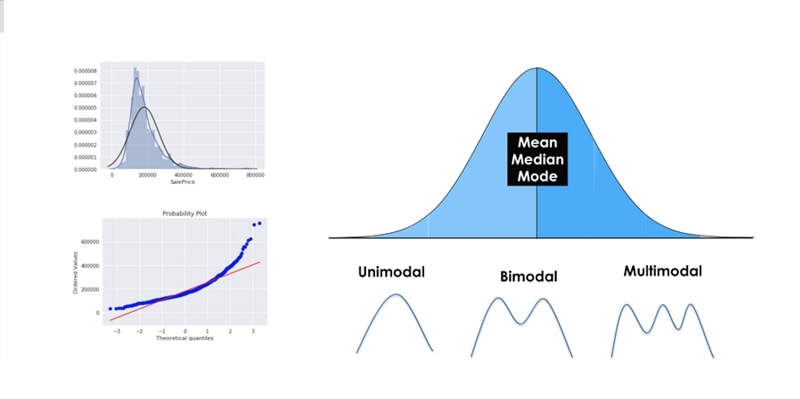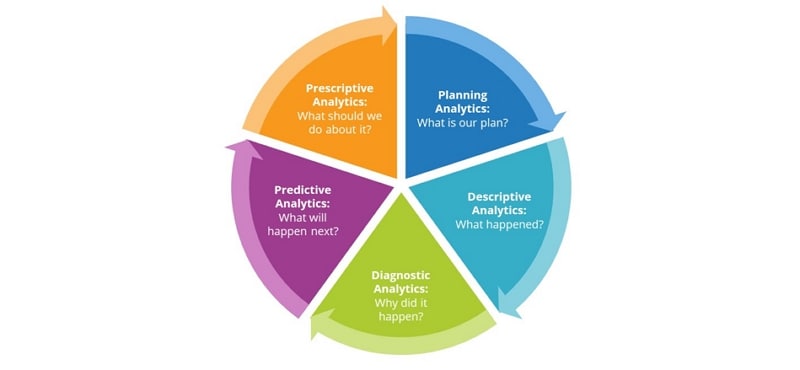Types of Data Analysis One Should Know
Data builds up, and individuals are curious about what can be achieved about it. Clearly, thousands of big data solutions are available, all promising to save your time and money and reveal unparalleled market insights as well. Before progressing to the more advanced techniques, we recommend you launch your data analysis efforts with a handful of simple but effective statistical analysis methods for big data. There are four simple types of data analysis in research listed here that you can begin with, along with the pitfalls, you have to look out for.
Four types of data analysis
Descriptive Analytics

Descriptive analysis, by definition, is the term used to interpret data that helps to explain, view, or summarise data in a concise way such that patterns can arise from the data, for example. The purpose is simple: you have a specific range of main success metrics, and the effect depending on the real performance of the company will be demonstrated by descriptive statistics.
In order to perform statistical analyses, a descriptive analysis is an important first step. It gives you an overview of the distribution of the results, lets you detect outliers and typos, and allows you to identify variables' correlations, making you ready to do more statistical analyses.
However, with so many forms of graphical and overview methods available, researchers are confused about which methodology to use for their data analysis. They either end up doing a number of analyses, wasting their resources, or missing this vital phase of statistical analysis altogether, thus raising their chances of making wrong decisions.
The best method for carrying out descriptive analyses is to first focus on the categories of variables and then use methods dependent on variable types for descriptive analyses.
Diagnostic Analytics
If the descriptive research demonstrates the “what" part of the story, then the analysis of diagnostics will tell you that this actually happened. The goal is to dig deeper into the matter and discover the causes of an idea, occurrence, or phenomenon that is given. Diagnostics enables businesses to identify links between company parameters. In order to understand why the top resume reviews or college paper reviews are better or worse than expected, content writing companies frequently focus on diagnostic research, for example. Online shopping stores also take advantage of the tactic to work out which marketing strategies are assisting them in maximizing conversions. Again the number of instances of potential use is infinite.
The development of accurate details is a crucial component of diagnostic analysis. It is likely because you have already obtained some data relevant to the problem as new problems occur. It ends up trying to replicate work, which makes both things intertwined by already having the data in your hands.
The diagnostic research market solutions include:
- A freight business that examines the cause of slow shipments in a specific area.
- In order to decide which marketing practices improved trials, a SaaS corporation drilled down.
Predictive Analytics

Predictive analysis is a technique used specifically to detect patterns and potential market performance. You should take advantage of predictive analysis to make promising data-driven decisions instead of guessing or relying on your instincts for decision-making purposes. It is essentially a method of statistical modeling which on a given topic, makes logical conclusions. What it actually means in practice is that risk analyses, predicted revenue, pinpoint high-converting leads, and so on can be done using predictive analysis.
The predictive analysis seeks to address "what is likely to happen" to the question. To make rational forecasts of the effects of events, the predictive analysis uses the data we have summarised. This research depends on mathematical modeling, which requires additional forecasting technologies and manpower. It is also necessary to note that forecasting is just an estimate; consistency and accurate data are the basis for the precision of forecasts.
Although standard business processes are descriptive and diagnostic research, predictive analysis is when many companies tend to display signs of difficulties. Predictive Analysis includes:
- Assessment of Threats
- Forecasting for Sales
- Using client segmentation to assess the leads are most likely to be transformed
- Predictive analytics in customer engagement
Prescriptive Analytics
The final method of data analysis is the most sought, but only a few organizations are fully prepared to execute it. The frontier of data analysis is prescriptive analysis, which incorporates the insight from all past studies to evaluate the course of action to take on a specific topic or decision.
Business intelligence's primary purpose is to discover ways to make choices that are easier and more precise. This is precisely what makes prescriptive research so important but also daunting. It is a mixture of analyses that are informative and predictive. By design, the field of business analytics devoted to finding the right course of action for a given scenario is prescriptive analytics. Logistics is the drawback to this approach because prescriptive analytics typically requires a lot of workforces and substantial budgeting.
State of the art technologies and research methods are used in the prescriptive study. It is an immense corporate commitment, and organizations need to make confident they are ready and able to bring the initiative and money forward.
A great example of prescriptive analytics is Artificial Intelligence (AI). Well-designed AI systems are capable of interacting and also bringing into effect these decisions.
Software for UX design
Wondershare Mockitt is an online platform for prototyping and sharing that lets you build immersive software wireframes and prototypes. By validating and executing the principle using this method, you will give life to your design concepts. With its versatility and welcoming user interface, Wondershare Mockitt stands out from all the other concept prototyping tools. In the best way possible, the platform helps you to test and apply the definition.

- Prototyping: Wondershare Mockitt lets you turn immersive prototypes without codes into highly animated concept designs. It has a wide variety of libraries of modules, components for linking, more than twenty models unique to the industry, and easy-to-drag functions.
- Interactive Linking: With dynamic transitions and movements, the platform helps you to imagine the final design. To drag and drop the links, use dynamic linking to demonstrate how the various pages connect.
- Dynamic Component: The dynamic components that make it possible for you to make animated elements are another great feature the tool offers.
- Handoff Feature: The handoff feature is another element that makes Wondershare Mockitt stand out from other rapid prototyping software. This helps you to put your team on the same page as the concept design is being developed.

